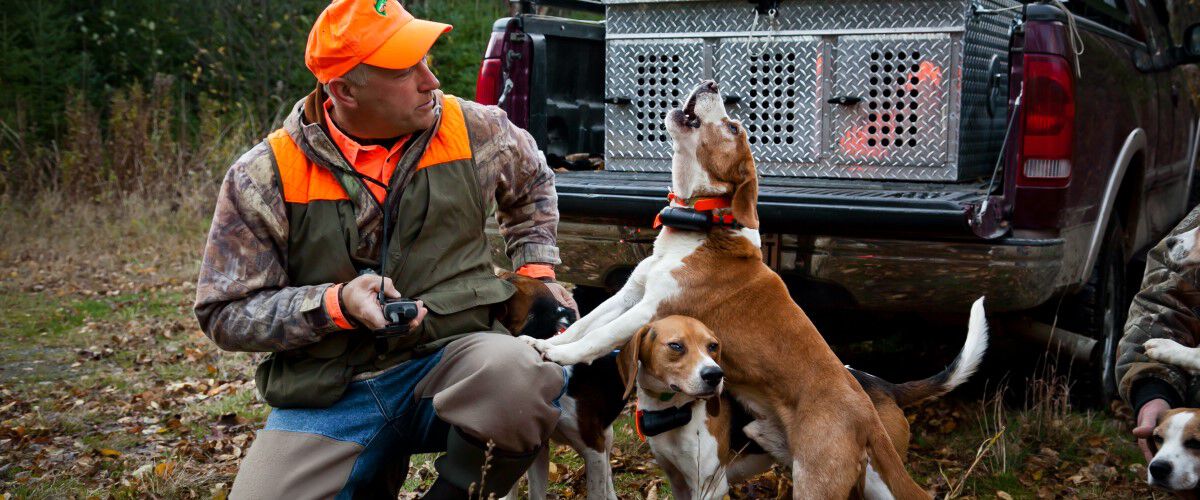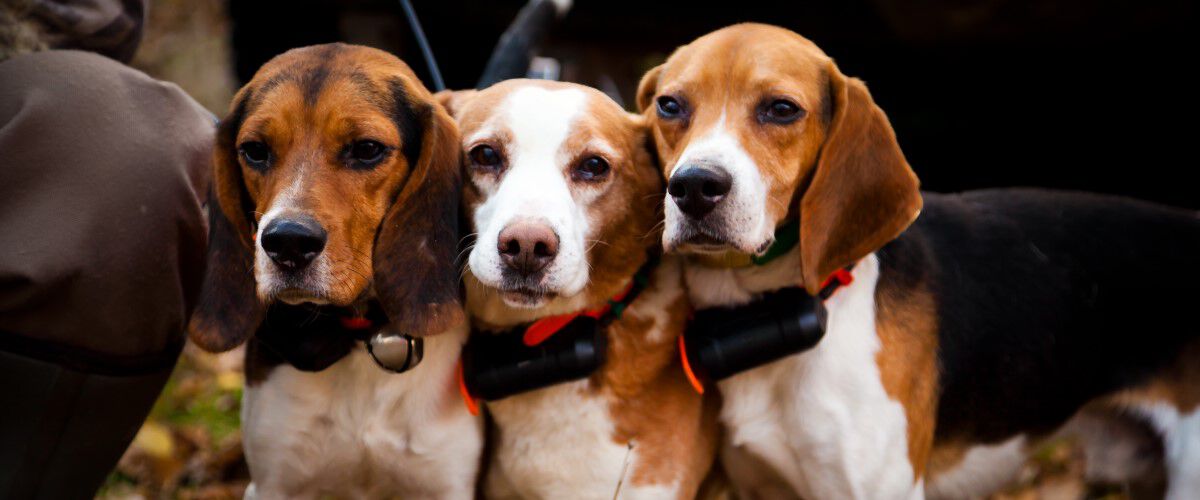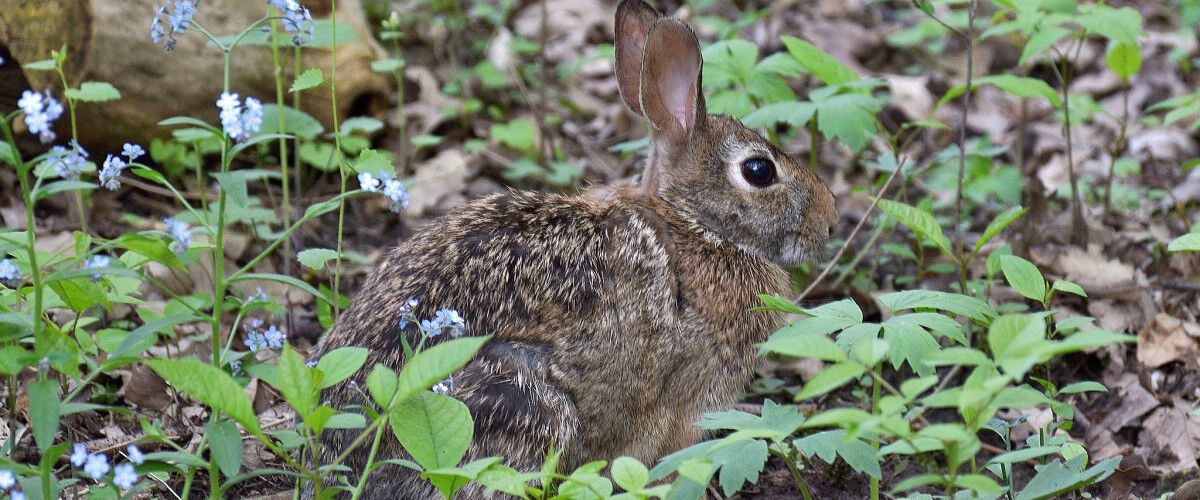All Hail The Cottontail
By Brad Fitzpatrick

On either side of the railroad track winter brown ironweed and blackberry bushes were silvered by morning frost. A hundred yards away Jason Olinger was standing on the same rail, gun in the crook of his arm while he watched the dry brush and the forest beyond. There was a growing hum echoing along the rail, but not from a locomotive. Instead, it was the roar of a pack of beagles growing closer and louder, and soon I could hear their individual voices: high, sharp yodels and deep howls all blended together in pack music as the dogs rushed like one twisting, scrambling organism through the rose thorns and over the cold, frozen ground. The dogs, as a single unit, were pulled to the left and right by the invisible scent trail, and sometimes the pack broke apart when the trail was lost and dogs went squirting in every direction. As soon as one of them found the track and they moved out.
I saw Jason lift his gun and fire. The crack of the shot didn’t distract the dogs, which made their way one by one to Jason and jumped up to reach the cottontail they’d been chasing for more than an hour. He turned a hoisted the rabbit at me and I raised a thumb in congratulations. Before I could reach him I heard one of the dogs howling, then a higher, sharp bark. Soon the whole lot was back in action, tearing across a vacant junkyard and running between the twisted pieces of metal.
“Looks like we’ve got another one going,” Jason said as he slid the rabbit into the pouch on his vest.
Of Kings & Commoners
Beagles, which were bred specifically for hunting in heavy brush where larger hounds became tangled, were popular with English royalty: King Henry VII and Queen Elizabeth I kept beagles. In the mid-19th century the beagle was imported to the United States, and soon many farmers had a beagle or two in the yard that lived to chase cottontails. No longer were beagles limited to large packs with royal lineage—now everyone could own and enjoy hunting with these hounds.

Hunting with beagles remains popular, and clubs like the UKC organize competitive beagle events. Some of these events pay very well, and a good beagle can make thousands of dollars, but the goal is simple: hounds must jump, circle and maintain a rabbit while judges look for qualities like line control, foot speed, and drive to hunt. In truth, hounds don’t “circle” rabbits at all. Cottontails have relatively small home ranges, and they prefer not to leave this familiar territory unless they have to. The “circle” is simply the rabbit’s own instinct to turn back and stay close to home. When the rabbit makes that turn to stay within its home territory it’s the job of the hunter to intercept the rabbit and get a shot.

Suppressor 22 LR
Whisper-quiet. Deadly as ever. CCI Suppressor’s subsonic velocity further reduces noise, yet the hollow-point bullet expands reliably for excellent terminal performance.
Buy NowShotguns are popular for hunting rabbits, but in most cases a 12-, 16- or even 20-gauge is more firearm than is required. Rabbits are soft-skinned and prefer thick brush, so shots are often close. A 28 gauge or .410 is ample (I’ve even used a .410 handgun), but a 22 LR or 17 HMR is also a good choice. Many hunters naturally assume a rabbit will be seen running from the dogs at full speed. That’s sometimes the case, especially on open ground, but the truth is that most rabbits being pursued will move four or five paces and then stop in cover. This gives the hunter the perfect opportunity for a shot. A rimfire head shot wastes none of the meat.
Hunting Without Hounds
Rabbit season in my home state of Ohio is open through February, and that’s a good time of year to walk through the woods searching for sheds, enjoying the snow, observing and tracking wildlife and hunting rabbits. A .22 rifle is the ideal weapon for spot-and-stalk winter rabbit hunting, and since the rabbits will likely be holding still, if you can locate them before they see you, then a .22 allows for a clean, killing shot. The trick to spotting a cottontail in thick cover? Look for their eyes. The rabbit’s pelt blends naturally with the browns and grays of the woods, but their eye, which looks like a shiny black marble, is unmistakable.
Winter spot-and-stalk rabbit hunts are great fun for the whole family. Where rabbits are abundant, a good day of hunting might turn up a half-dozen or more cottontails, and a fresh snowfall improves the odds of success because it’s easier to spot tracks and the rabbits themselves. Kids like it because spot-and-stalk rabbit hunts don’t require an early wake up call and the odds of success are pretty high. The public hunting areas around my home are quite busy during deer and dove season, but while hunting rabbits in winter you’ll oftentimes have these completely to yourself.

The Reward
Rabbit meat is enjoyed by many people because it’s similar in taste and texture to chicken, though rabbits do carry disease so every carcass should be inspected and the meat thoroughly cooked. Rabbit can be substituted in most chicken recipes, so I use it in place of poultry when I’m fixing fajitas or buffalo dip. One of my favorite recipes is to blend cooked and shredded rabbit meat with mayonnaise, onion, chili powder, salt and pepper. This blend can be scooped into a halved and cleaned jalapeno. The jalapeno is wrapped in bacon (pre-cooking a bit helps, as bacon is slow to brown) and placed in a 400-degree oven for 20 minutes or so until cooking is complete. The result is a delicious, flavorful, and filling wild game appetizer. Because I enjoy eating rabbit, I prefer to hunt them with a rimfire rifle. I might miss a few shots on running cottontails, but I estimate that I lose on average 25 percent less meat on cottontails killed by rimfires.
Rabbits are fun to hunt, widely available, and delicious, and if you don’t spend some time in the fall and winter chasing them, you are missing a great opportunity. You might just find that America’s favorite first game animal is also its most fun to hunt.